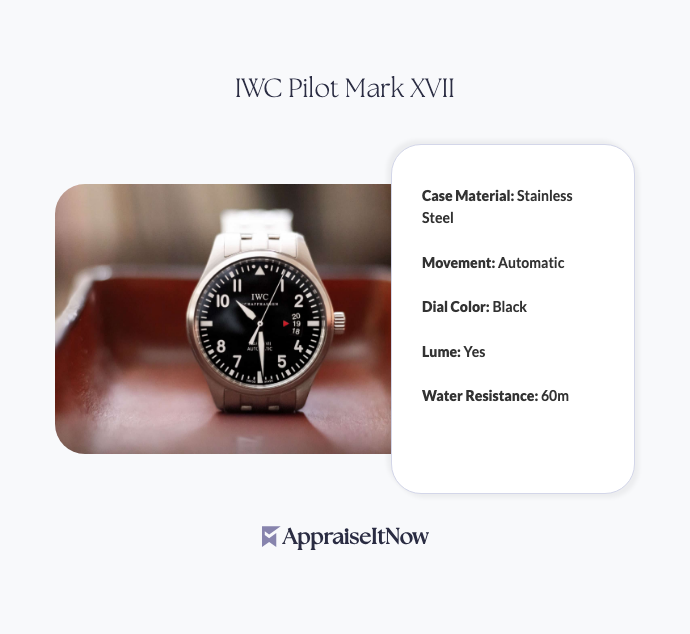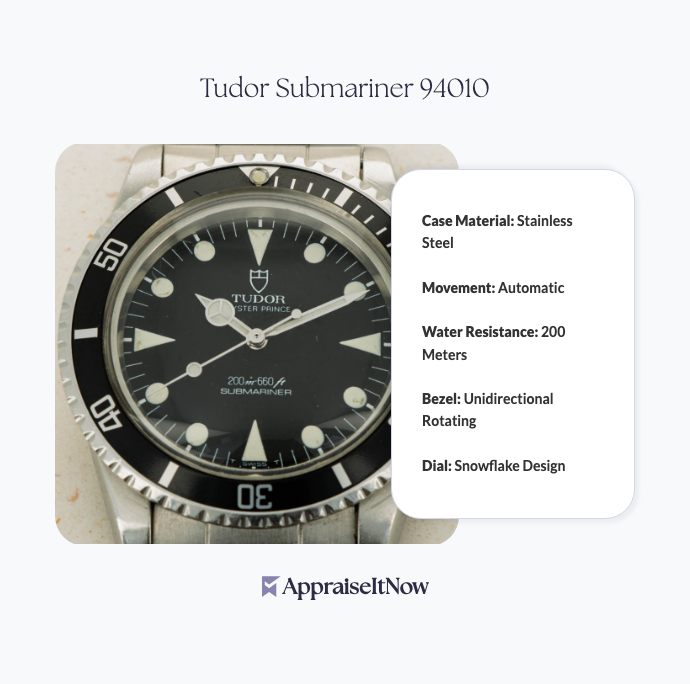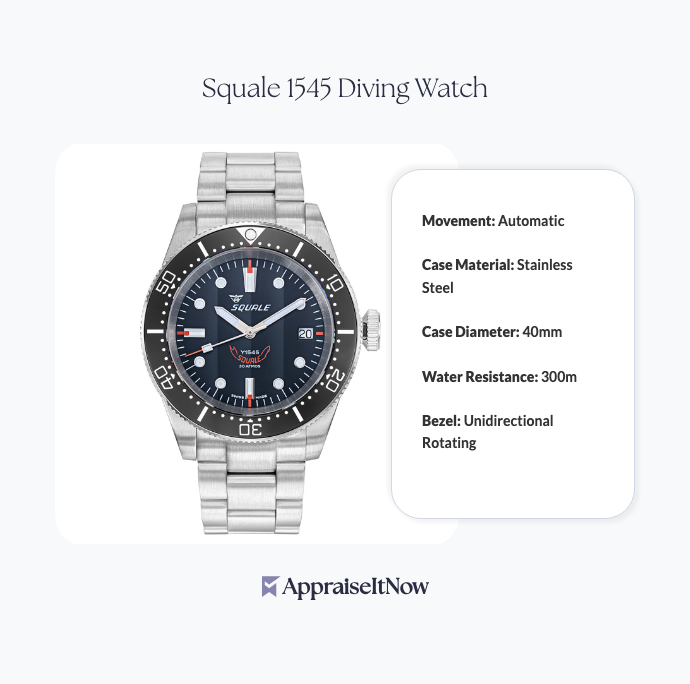<h1>How to Get Your IWC Pilot Mark XVII Appraised</h1>
<p>The IWC Pilot Mark XVII is a prized timepiece among aviation enthusiasts and collectors, with current market values ranging from <strong>$3,500 to $6,000</strong>. Whether you're buying, selling, or ensuring proper insurance coverage, understanding how to navigate the professional appraisal process for this iconic Swiss watch will help you make confident decisions about your investment.</p>
<h2>What Makes the IWC Pilot Mark XVII Valuable</h2>
<p>Your Mark XVII represents more than just a functional timepiece—it's a piece of horological history with a lineage stretching back to the 1940s. The iconic flieger-style design, paired with the watch's legendary reliability and 39mm stainless steel case, has made it a sought-after collectible in the luxury watch market. The combination of its sturdy construction, luminous hands and Arabic numerals, and automatic mechanical movement creates a tool watch that refuses to go out of style.</p>
<p>The specific condition, provenance, and whether you have the original box and papers can swing your watch's value significantly within that $3,500–$6,000 range. A well-documented example with full set accessories might command the higher end, while a watch with missing documentation or service history gaps could fall toward the lower spectrum.</p>
<div class="callout tip"><p><strong>Collector's Note</strong></p>
<p>The original screw-down caseback and luminous indices are hallmark features that appraisers scrutinize closely—these details verify authenticity and influence valuation considerably.</p></div>
<h2>Key Factors That Determine Your Watch's Market Value</h2>
<p>When a professional appraiser evaluates your IWC Pilot Mark XVII, they assess multiple dimensions of value. Model year matters—early production runs or special editions carry different worth than later versions. The movement inside the case, whether it's an original mechanical automatic or has been serviced, affects desirability and price. A watch with original, unpolished case geometry and untouched dial commands respect among serious collectors.</p>
<p>Provenance documentation is equally important. If you can provide service records showing regular maintenance by authorized IWC dealers, you're building a credible ownership history. Conversely, a watch with gaps in documentation or evidence of unauthorized servicing may reduce confidence in its condition assessment. The presence of original box, warranty cards, and related paperwork can add 10–20% to a watch's appraised value compared to a "loose" example without accessories.</p>
<h2>Why Professional Appraisers Use Multiple Valuation Approaches</h2>
<p>Professional appraisers don't rely on a single method to determine your Mark XVII's worth. The <strong>comparative sales approach</strong> examines recent secondary market transactions—what similar examples actually sold for on auction platforms or through specialty dealers. This gives market-based reality checks. The <strong>cost approach</strong> considers manufacturing, materials, and brand overhead, though this rarely applies to luxury watches where brand prestige dominates. When <a href="/blog/appraising-luxury-watches-determining-the-value-of-timepiece-investments">evaluating luxury watches</a>, appraisers distinguish between replacement retail value (what a new Mark XVII costs today) and fair market value (what a pre-owned example commands).</p>
<p>For insurance purposes, you'll often need <strong>replacement cost value</strong>—the amount required to purchase a comparable watch if yours is lost or damaged. For sale or estate settlement, <strong>fair market value</strong> is the standard, reflecting what a willing buyer and seller would agree upon in an arm's-length transaction. These distinctions matter legally and financially, so clarity in your appraisal report is essential.</p>
<div class="callout note"><p><strong>Appraisal Insight</strong></p>
<p>USPAP-compliant appraisals clearly specify which valuation approach and value type applies to your watch, ensuring the report serves its intended purpose without ambiguity.</p></div>
<h2>Documentation You'll Need for Online or Remote Appraisal</h2>
<p>AppraiseItNow and similar platforms enable you to submit appraisals remotely, often more conveniently than in-person evaluations. To receive an accurate remote valuation of your IWC Pilot Mark XVII, prepare comprehensive photographic documentation. High-resolution images of the dial, caseback, lugs, crown, and any serial number engravings help appraisers verify authenticity and condition. Include close-up shots showing the condition of the bezel, crystal clarity, and any signs of previous repair or refinishing.</p>
<p>Gather any supporting documentation: original purchase receipts, warranty cards, service records, original box and papers, or certificates of authenticity if available. Even partial documentation strengthens the appraisal. A written description noting any repairs, replacements, or modifications is invaluable. The more detail you provide upfront, the faster and more confident your appraiser can be in their valuation.</p>
<h2>Authentication: How Credentialed Appraisers Verify Your Watch</h2>
<p>Distinguishing a genuine IWC Pilot Mark XVII from a counterfeit requires specialized expertise that trained appraisers bring to the table. These professionals examine the movement's construction—IWC uses specific caliber designations, finishing quality, and component specifications that fakes frequently mishandle. They inspect the dial for printing clarity, lume color consistency, and hand construction details that reveal age and originality. Serial number research cross-references IWC production records to confirm manufacture date and model verification.</p>
<p>Authentication also involves scrutinizing case markings, hallmarks, and engravings. The screw-down caseback presents an opportunity to inspect the movement directly—appraisers look for correct caliber designations, jewel counts, and manufacturing marks. Micro-details like laser-etched case references, logo proportions, and lume application techniques distinguish authentic pieces from sophisticated counterfeits. This technical diligence protects your investment and ensures your appraisal stands up to professional scrutiny.</p>
<p>Certified appraisers from recognized organizations like <strong>AAA (American Association of Appraisers), ISA (International Society of Appraisers), ASA (American Society of Appraisers), CAGA, and AMEA</strong> maintain standards ensuring their authentication methods are defensible and accepted by insurance companies, courts, and financial institutions. When seeking a <a href="/blog/what-you-need-to-know-about-rare-watch-appraisals">rare watch appraisal</a>, professional credentials matter significantly.</p>
<div class="callout tip"><p><strong>Verification Step</strong></p>
<p>Request your appraiser's credentials and memberships in recognized organizations—these certifications ensure USPAP compliance and professional accountability.</p></div>
<h2>Understanding Appraisal Timelines and Costs</h2>
<p>How long does a professional IWC Pilot Mark XVII appraisal take? Online appraisals typically require 3–7 business days from submission to final report, depending on appraiser workload and documentation completeness. In-person appraisals at a local office might be completed same-day, though turnaround for formal written reports still usually takes 5–10 business days. The advantage of remote appraisal is convenience and access to specialists regardless of geography.</p>
<p>Appraisal fees for luxury watches typically range from <strong>$300 to $800 or more</strong>, depending on complexity, urgency, and the watch's value tier. Your fee generally includes the detailed written report with comparative market analysis, high-resolution photography, authentication documentation, and methodology explanation. Some appraisers charge flat rates, while others use hourly fees or percentage-based models. Clarify upfront what your fee includes so there are no surprises. A professional <a href="/blog/a-guide-to-professional-personal-property-appraisals">personal property appraisal</a> protects your interests across buying, selling, insurance, estate, and tax scenarios.</p>
<h2>How Your Appraisal Report Serves Multiple Purposes</h2>
<p>Your completed IWC Pilot Mark XVII appraisal is a versatile document. If you're <strong>selling</strong>, a certified appraisal from a recognized expert strengthens your asking price and provides transparency to potential buyers. For <strong>insurance replacement coverage</strong>, the appraisal establishes replacement cost and protects you if the watch is lost, stolen, or damaged. In <strong>estate planning</strong>, appraisals document asset values for distribution among heirs and provide necessary evidence for tax and probate purposes. If facing a <strong>donation</strong>, certified valuations help maximize tax deductions and satisfy IRS documentation requirements when giving watches to charitable organizations.</p>
<p>Understanding the watch's valuation also benefits you when making <strong>investment decisions</strong>. Knowing whether your Mark XVII is appreciating or depreciating helps inform whether to hold, sell, or upgrade. A formal appraisal creates a baseline for future comparisons, allowing you to track how market conditions affect your collection's worth over time.</p>
<h2>The Importance of USPAP Compliance for Defensible Valuations</h2>
<p>USPAP (Uniform Standards of Professional Appraisal Practice) compliance matters whether you're managing <a href="/types/personal-property">personal property</a> or high-value collectibles. Appraisals meeting USPAP standards withstand scrutiny from insurance adjusters, attorneys, and tax authorities. These standards ensure your appraiser follows consistent methodologies, discloses any conflicts of interest, supports conclusions with market data, and documents reasoning transparently.</p>
<p>A USPAP-compliant appraisal of your IWC Pilot Mark XVII is your protection against disputes. If an insurance claim is contested or a tax deduction is questioned, the professional rigor embedded in a compliant appraisal report defends your position. When working with platforms like AppraiseItNow, appraisers with credentials from established organizations (AAA, ISA, ASA, CAGA, AMEA) guarantee this compliance standard, giving you confidence your valuation is legally defensible.</p>
<h2>Current Market Trends Affecting Your Mark XVII's Value</h2>
<p>The luxury watch market has shifted significantly in recent years. Pre-owned sport watches and pilot chronographs—especially iconic tool watches like the IWC Pilot—have appreciated as availability of new watches tightens and collector interest intensifies. Your Mark XVII benefits from this trend, particularly if it represents an earlier production run or carries notable service history from respected watchmakers.</p>
<p>Supply scarcity is pushing collector attention toward quality secondary market examples. As newer IWC models command premium retail prices, buyers increasingly seek well-maintained vintage and pre-owned variants offering similar heritage at lower entry points. This dynamic supports fair market values in the $3,500–$6,000 range for quality Mark XVIIs, with potential for appreciation if market conditions remain favorable.</p>
<div class="callout note"><p><strong>Market Perspective</strong></p>
<p>Secondary market watches with documented service history and original components often outperform heavily modified or poorly maintained examples as collector preferences favor authenticity and reliability.</p></div>
<h2>Choosing Your Appraisal Provider</h2>
<p>When selecting an appraiser for your IWC Pilot Mark XVII, prioritize credentials and specialization. Look for professionals with <strong>specific expertise in luxury watches</strong> rather than generalist appraisers. Verify membership in recognized organizations, request references, and ask about their authentication methodology. Understanding their approach to comparative market analysis and how they distinguish fair market value from retail replacement cost ensures their report aligns with your needs.</p>
<p>AppraiseItNow and similar platforms vet their network of credentialed professionals, streamlining your search. Communicate clearly whether you need the appraisal for insurance, sale, estate, or tax purposes—this allows your appraiser to tailor their report appropriately. A professional appraiser takes time to understand your watch's unique characteristics and circumstances, recognizing that even within the Mark XVII family, variations in production, service history, and condition create meaningful value differences.</p>
<hr />
<div class="callout note"><p><strong>Key Takeaway</strong></p>
<p>A certified appraisal of your IWC Pilot Mark XVII provides confidence in its true market value, whether you're buying, selling, insuring, or planning your estate. Professional expertise combined with USPAP compliance ensures your appraisal withstands scrutiny, serves your intended purpose, and protects your investment in this timeless aviator's watch.</p></div>







.avif)







